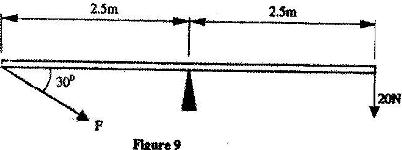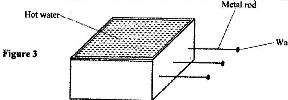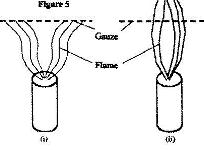Clockwise moments = Anticlockwise moment
0.4 x 8 N = 0.35 x 4N + 0.5 x T
3.2 = 1.4 + 0.5T
0.5T = 3.2 - 1.4
T = $\frac{1.8}{0.5}$ = 3.6 N
johnmulu answered the question on April 18, 2017 at 12:54
-
Figure 5 shows a uniform rod 4 m and of mass 2 kg. It is pivoted 1 m from one end and balanced horizontally by a string attached near the other end
(Solved)
Figure 5 shows a uniform rod 4 m and of mass 2 kg. It is pivoted 1 m from one end and balanced horizontally by a string attached near the other end

Determine the position where a mass of 5 kg should be placed on the rod so that the rod remains horizontally by a string attached near the other end.
Date posted:
April 18, 2017
.
Answers (1)
-
Figure 9 shows a uniform bar in equilibrium under the action of two forces.
(Solved)
Figure 9 shows a uniform bar in equilibrium under the action of two forces.

Determine the value of F.
Date posted:
April 18, 2017
.
Answers (1)
-
Figure 4 shows a uniform metre rule of weight I N with two weights of 0.18 N and 0.12 N suspended from its ends.
(Solved)
Figure 4 shows a uniform metre rule of weight I N with two weights of 0.18 N and 0.12 N suspended from its ends.

Determine how far from the 0.18 N weight a pivot should be placed in order to balance the meter rule
Date posted:
April 18, 2017
.
Answers (1)
-
Figure 1 shows a vernier calipers being used to measure the internal diameter of a tube
(Solved)
Figure 1 shows a vernier calipers being used to measure the internal diameter of a tube

Record the diameter of the tube
Date posted:
April 18, 2017
.
Answers (1)
-
Figure 3 shows part of an experimental set up for estimating the diameter of an oil molecule.
(Solved)
Figure 3 shows part of an experimental set up for estimating the diameter of an oil molecule.

i) Describe how the oil patch is formed.
ii) Describe one method of determining the diameter of the oil drop
Date posted:
April 18, 2017
.
Answers (1)
-
Figure 1 shows a micrometer screw gauge being used to measure the diameter of a ball bearing. A magnified portion of the scale is shown
(Solved)
Figure 1 shows a micrometer screw gauge being used to measure the diameter of a ball bearing. A magnified portion of the scale is shown

Date posted:
April 18, 2017
.
Answers (1)
-
Figure 1 shows a micrometer screw gauge being used to measure the diameter of a metal rod. The thimble scale has 50 divisions
(Solved)
Figure 1 shows a micrometer screw gauge being used to measure the diameter of a metal rod. The thimble scale has 50 divisions

What is the reading shown?
Date posted:
April 18, 2017
.
Answers (1)
-
The micrometer screw gauge represented by Fig.1 has thimble scale of 50 divisions. What is the reading shown?
(Solved)
The micrometer screw gauge represented by Fig.1 has thimble scale of 50 divisions. What is the reading shown?

Date posted:
April 18, 2017
.
Answers (1)
-
Figure 2 shows a soft iron bar AB placed in a coil near a freely suspended magnet.
(Solved)
Figure 2 shows a soft iron bar AB placed in a coil near a freely suspended magnet.

Explain the observation made when the switch is closed.
Date posted:
April 18, 2017
.
Answers (1)
-
Figure 2 shows a horse – shoe magnet whose poles are labeled and two other magnets near it. Iron nails are attracted to the lower ends of the magnets as shown.
(Solved)
Figure 2 shows a horse – shoe magnet whose poles are labeled and two other magnets near it. Iron nails are attracted to the lower ends of the magnets as shown.

Identify the poles marked X and Y
Date posted:
April 18, 2017
.
Answers (1)
-
Figure 7 shows how magnets are stored in pairs with keepers at the ends
(Solved)
Figure 7 shows how magnets are stored in pairs with keepers at the ends. Explain how this method of storing helps in retaining magnetic longer

Date posted:
April 18, 2017
.
Answers (1)
-
In an experiment to magnetize two substances p and Q using electric currents, two curves (graphs) were obtained as shown in fig. 1
(Solved)
In an experiment to magnetize two substances p and Q using electric currents, two curves (graphs) were obtained as shown in fig. 1

Using this information in Fig. 1 explain the difference between the substances P and Q with reference to the domain theory
Date posted:
April 18, 2017
.
Answers (1)
-
Figure 4 shows the cross-section of a dry cell. Use the information on the figure to answer question a) and b)
(Solved)
Figure 4 shows the cross-section of a dry cell. Use the information on the figure to answer question a) and b)

a) Name the parts labeled A and B
b) State the use of manganese (IV) oxide in the cell.
Date posted:
April 18, 2017
.
Answers (1)
-
Figure 12, shows an electrical circuit including three switches, S1, S2, S3 and three identical lamps L1, L2, L3. A constant potential difference is applied across X and Y.
(Solved)
Figure 12, shows an electrical circuit including three switches, S1, S2, S3 and three identical lamps L1, L2, L3. A constant potential difference is applied across X and Y.

i) Other than L1, state the lamp that will light when S1 and S2 are closed.
ii) How does the brightness in L1 in (i) above compare with its brightness when all the switches are closed?
iii) Explain the observation in (ii) above
Date posted:
April 18, 2017
.
Answers (1)
-
Figure 7 shows the features of a dry cell (Leclanche’s). Use the information in the figure to answer the questions a and b
(Solved)
Figure 7 shows the features of a dry cell (Leclanche’s). Use the information in the figure to answer the questions a and b

a) State the polarities of the parts labeled A and B.
b) Name the chemical substance in the parts labeled C and D
Date posted:
April 18, 2017
.
Answers (1)
-
Figure 7 shows a highly negatively charged rod being brought slowly near the cap of a positively charged leaf electroscope. If is observed that the leaf initially falls and then rises
(Solved)
Figure 7 shows a highly negatively charged rod being brought slowly near the cap of a positively charged leaf electroscope. If is observed that the leaf initially falls and then rises

Explain this observation.
Date posted:
April 17, 2017
.
Answers (1)
-
Figure 4 shows a source of heat placed at equal distances from two identical flasks X and Y containing air. The surface of X is painted black while Y is clear.
(Solved)
Figure 4 shows a source of heat placed at equal distances from two identical flasks X and Y containing air. The surface of X is painted black while Y is clear.

X and Y are linked by a U-tube filled with whose levels S and T are initially the same. It is later observed that S falls while T rises. Explain this observation.
Date posted:
April 17, 2017
.
Answers (1)
-
A paper windmill in a horizontal axis was placed above a candle as shown in Figure 2. When the candle was lit the paper windmill begun to rotate. Explain this observation
(Solved)
A paper windmill in a horizontal axis was placed above a candle as shown in Figure 2. When the candle was lit the paper windmill begun to rotate. Explain this observation

Date posted:
April 17, 2017
.
Answers (1)
-
Figure 3 shows a hot water bath with metal rods inserted through one of its side. Some wax is fixed at the end of each rod. Use this information to answer questions
(Solved)
Figure 3 shows a hot water bath with metal rods inserted through one of its side. Some wax is fixed at the end of each rod. Use this information to answer questions

a) What property of metals could be tested using this set-up?
b) Besides the length of the rods that is kept constant, what else should be kept constant when comparing the property for the different metal rods?
Date posted:
April 17, 2017
.
Answers (1)
-
When a Bunsen burner is lit below wire guaze, it is noted that the flame initially burns below the guaze as shown in Figure 5 (i). After sometimes, the flame burns below as well as above the gauze in figure 5 (5) (ii)
(Solved)
When a Bunsen burner is lit below wire guaze, it is noted that the flame initially burns below the guaze as shown in Figure 5 (i). After sometimes, the flame burns below as well as above the gauze in figure 5 (5) (ii)

Explain this observation.
Date posted:
April 17, 2017
.
Answers (1)